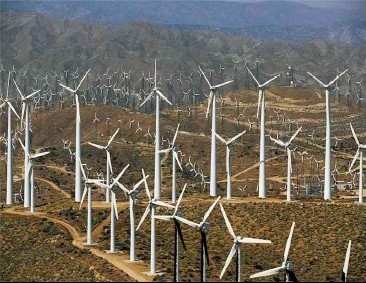Wed, Sep 08, 2010
Raytheon, NATS Work To Develop New Hardware, Processing
Several times over the past year, ANN has reported on stories in
which proposed windfarms have come into conflict with the nation's
air traffic system. One of the most common problems is radar
interference caused by the giant, spinning blades of the wind
turbines which are, in some cases, indistinguishable from aircraft.
Some claim that air traffic concerns are stunting the growth of
wind power in the United States.

Putting a set of turbines across an area can look like a "great
field of moving objects," according to Raytheon Digital Airport
Surveillance Radar technical director Peter Drake. "It's a very
real problem." He said that in addition to the spinning blades
appearing to be aircraft on radar screens, the interference can
cause a legitimate target to suddenly shift its position.
The online technology magazine CNET reports that Raytheon and
Europe's National Air Traffic Services have been collaborating on
potential mitigations of the interference for the past two years.
Raytheon Canada general manager Brian Smith said some of the same
techniques being developed overseas could be applicable to the U.S.
as well. One such solution is called concurrent beam processing,
which allows radar systems to differentiate between targets in the
air and ground clutter. Another involves more detailed terrain maps
that allow stationary turbines to be screened out, leaving only the
moving objects.
But these and other potential solutions to the problem require
upgrading the radar hardware to allow it to process more data along
with software updates. Smith says he is confident that the partners
have come up with workable fixes.
Turbine manufacturers are reportedly doing their part as well,
working on "stealth" technology that would reduce the radar
signature of the devices. But Gary Siefert at the Idaho National
Laboratories, a recognized expert on wind-radar conflicts, says
most of the windfarms will have to be addressed on a case-by-case
basis. "Anybody who says they can solve all the problems is
probably overstating," he said.
More News
Airport Rotating Beacon A visual NAVAID operated at many airports. At civil airports, alternating white and green flashes indicate the location of the airport. At military airports>[...]
Aero Linx: Fly for the Culture Fly For the Culture, Inc. is a 501(c)(3) non-profit organization that serves young people interested in pursuing professions in the aviation industry>[...]
Klyde Is Having Some Issues Comprehending The Fed's Priorities FMI: www.klydemorris.com>[...]
Also: Viasat-uAvionix, UL94 Fuel Investigation, AF Materiel Command, NTSB Safety Alert Norges Luftsportforbund chose Aura Aero's little 2-seater in electric trim for their next gli>[...]
Also: EP Systems' Battery, Boeing SAF, Repeat TBM 960 Order, Japan Coast Guard H225 Buy Despite nearly 100 complaints totaling millions of dollars of potential fraud, combined with>[...]
 ANN's Daily Aero-Term (04.25.24): Airport Rotating Beacon
ANN's Daily Aero-Term (04.25.24): Airport Rotating Beacon ANN's Daily Aero-Linx (04.25.24)
ANN's Daily Aero-Linx (04.25.24) Klyde Morris (04.22.24)
Klyde Morris (04.22.24) Airborne 04.24.24: INTEGRAL E, Elixir USA, M700 RVSM
Airborne 04.24.24: INTEGRAL E, Elixir USA, M700 RVSM Airborne 04.22.24: Rotor X Worsens, Airport Fees 4 FNB?, USMC Drone Pilot
Airborne 04.22.24: Rotor X Worsens, Airport Fees 4 FNB?, USMC Drone Pilot



